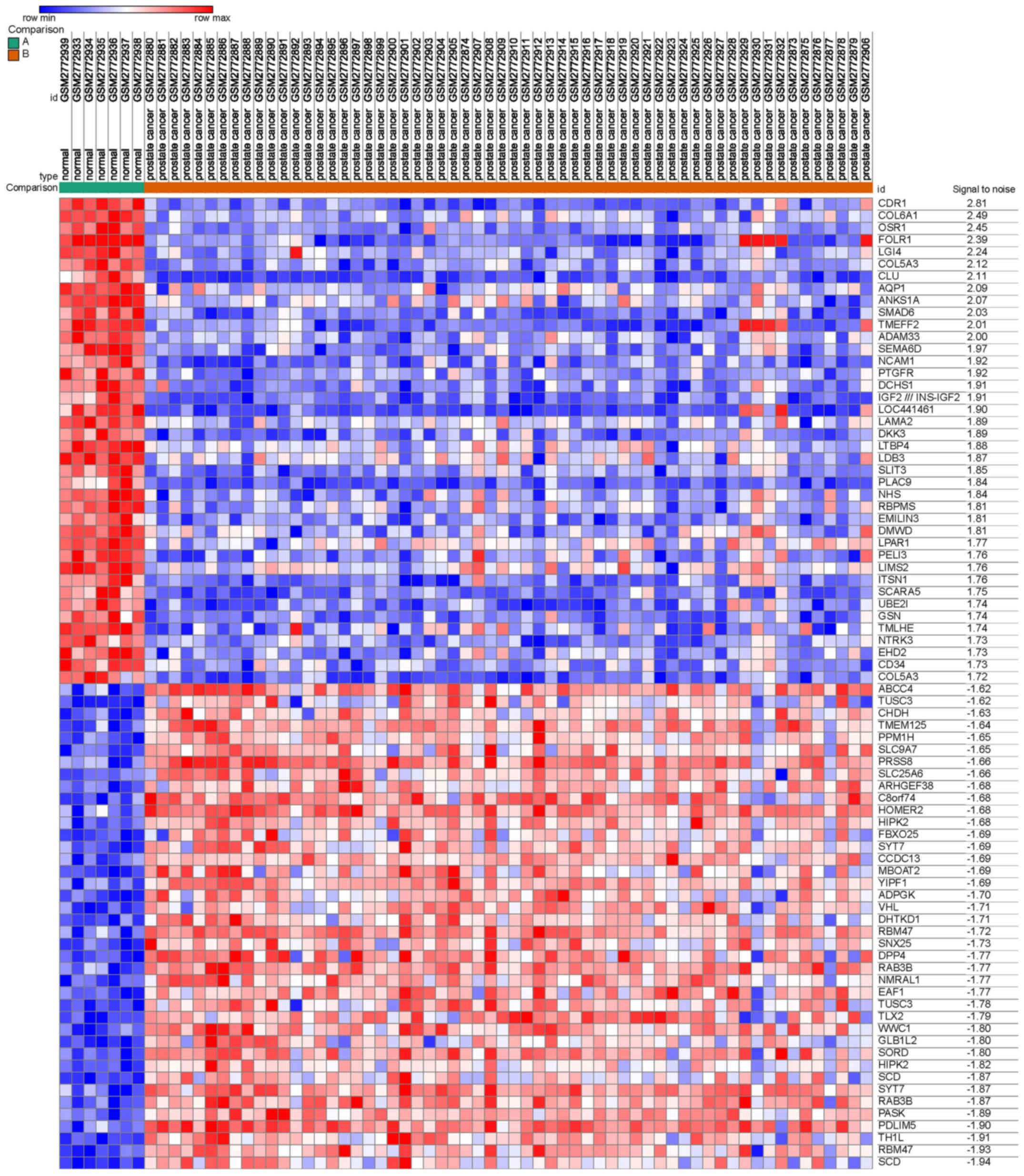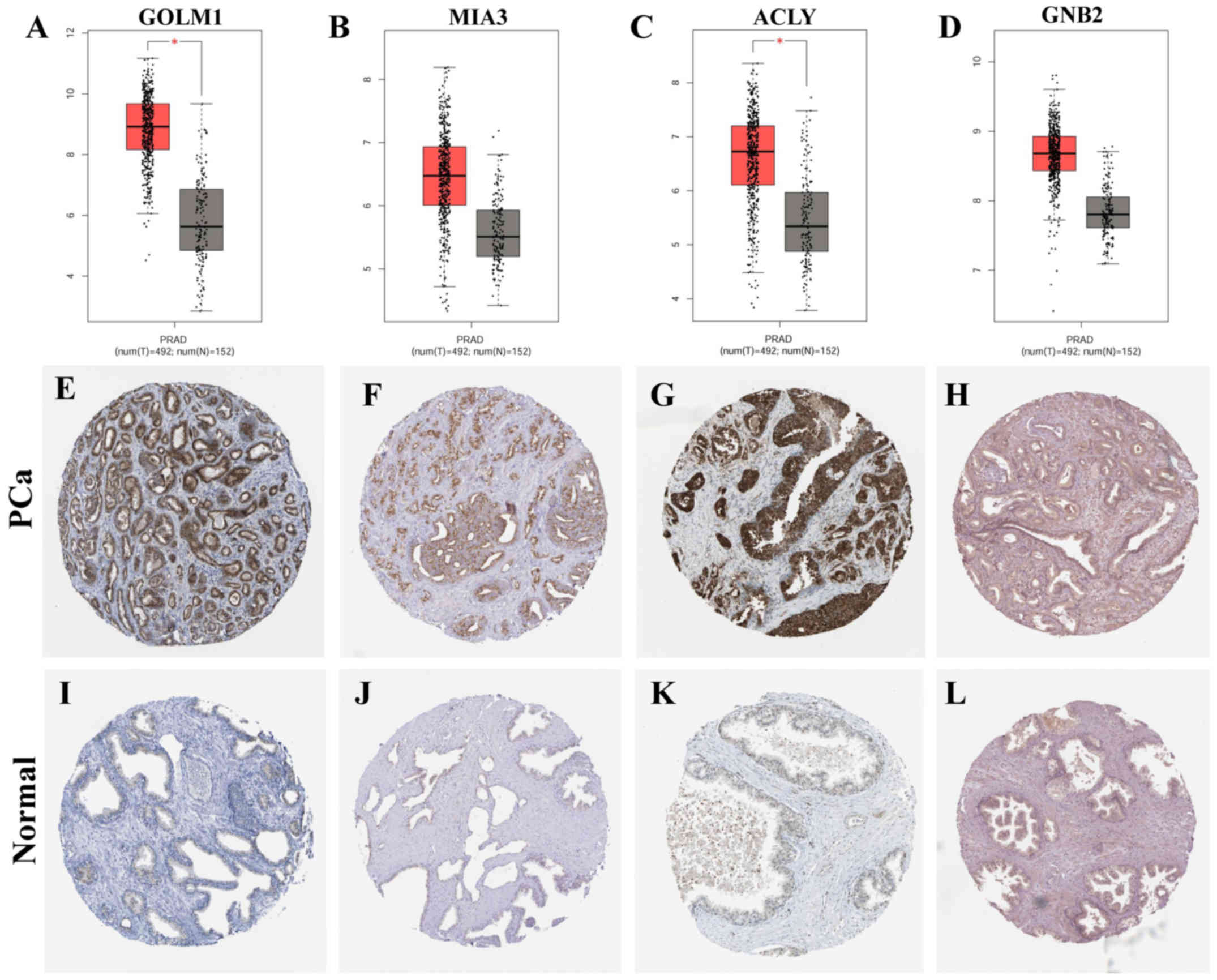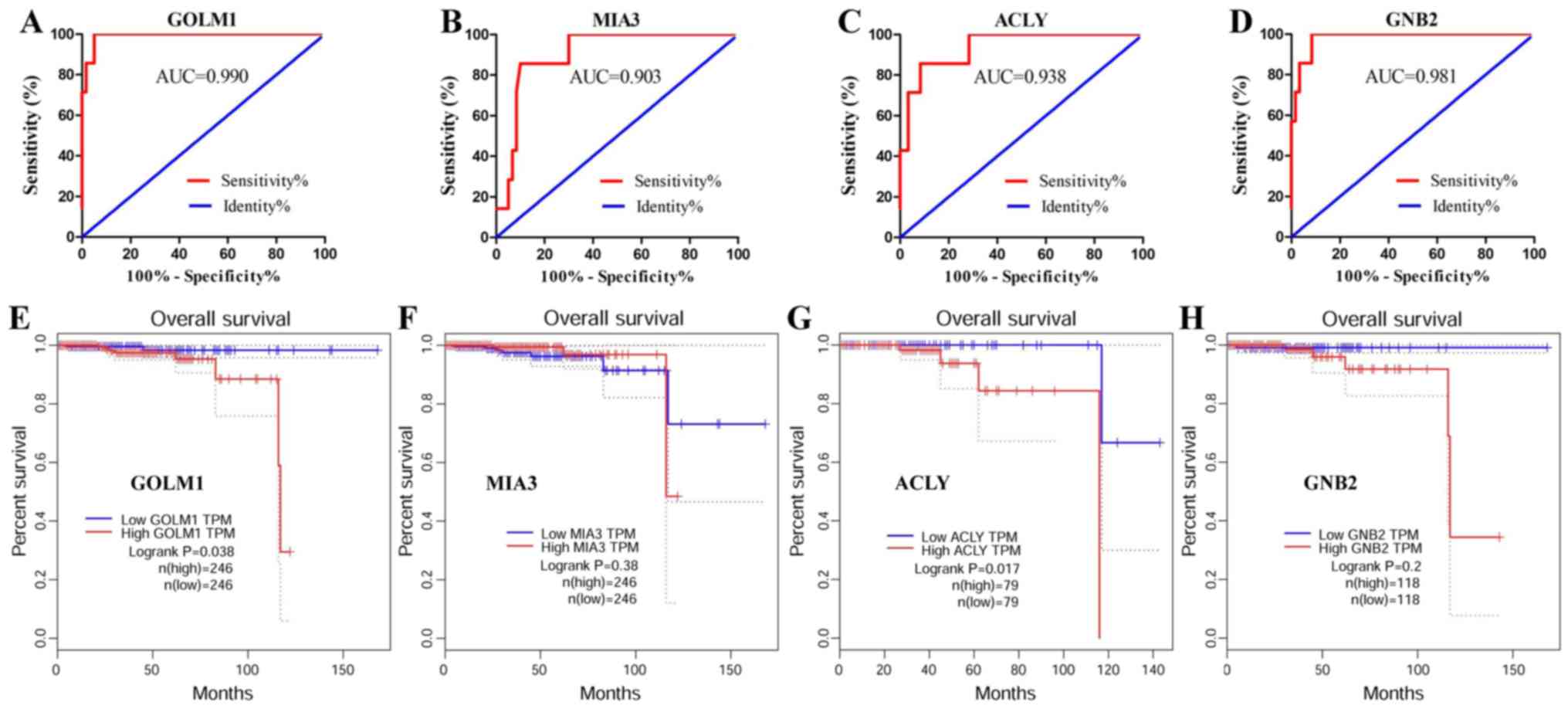|
1
|
Yan G, Ru Y, Wu K, Yan F, Wang Q, Wang J,
Pan T, Zhang M, Han H, Li X and Zou L: GOLM1 promotes prostate
cancer progression through activating PI3K-AKT-mTOR signaling.
Prostate. 78:166–177. 2018. View Article : Google Scholar : PubMed/NCBI
|
|
2
|
Zhao H, Zhao X, Lei T and Zhang M:
Screening, identification of prostate cancer urinary biomarkers and
verification of important spots. Invest New Drugs. Jan 4–2019.(Epub
ahead of print). View Article : Google Scholar
|
|
3
|
Siegel RL, Miller KD and Jemal A: Cancer
statistics, 2018. CA Cancer J Clin. 68:7–30. 2018. View Article : Google Scholar : PubMed/NCBI
|
|
4
|
Kudryavtseva AV, Lukyanova EN, Kharitonov
SL, Nyushko KM, Krasheninnikov AA, Pudova EA, Guvatova ZG, Alekseev
BY, Kiseleva MV, Kaprin AD, et al: Bioinformatic identification of
differentially expressed genes associated with prognosis of locally
advanced lymph node-positive prostate cancer. J Bioinform Computat
Biol. 17:19500032019. View Article : Google Scholar
|
|
5
|
Gadzinski AJ and Cooperberg MR: Prostate
cancer markers. Cancers Treat Res. 175:55–86. 2018. View Article : Google Scholar
|
|
6
|
Fujita K and Nonomura N: Urinary
biomarkers of prostate cancer. Int J Urol. 25:770–779. 2018.
View Article : Google Scholar : PubMed/NCBI
|
|
7
|
Thompson IM, Pauler DK, Goodman PJ, Tangen
CM, Lucia MS, Parnes HL, Minasian LM, Ford LG, Lippman SM, Crawford
ED, et al: Prevalence of prostate cancer among men with a
prostate-specific antigen level < or =4.0 ng per milliliter. N
Engl J Med. 350:2239–2246. 2004. View Article : Google Scholar : PubMed/NCBI
|
|
8
|
Kulasingam V and Diamandis EP: Strategies
for discovering novel cancer biomarkers through utilization of
emerging technologies. Nat Clin Pract Oncol. 5:588–599. 2008.
View Article : Google Scholar : PubMed/NCBI
|
|
9
|
Liang B, Li C and Zhao J: Identification
of key pathways and genes in colorectal cancer using bioinformatics
analysis. Med Oncol. 33:1112016. View Article : Google Scholar : PubMed/NCBI
|
|
10
|
Lascorz J, Hemminki K and Försti A:
Systematic enrichment analysis of gene expression profiling studies
identifies consensus pathways implicated in colorectal cancer
development. J Carcinog. 10:72011. View Article : Google Scholar : PubMed/NCBI
|
|
11
|
Cheng Y, Wang K, Geng L, Sun J, Xu W, Liu
D, Gong S and Zhu Y: Identification of candidate diagnostic and
prognostic biomarkers for pancreatic carcinoma. EBioMedicine.
40:382–393. 2019. View Article : Google Scholar : PubMed/NCBI
|
|
12
|
Shinichi Y, Sian J, Ivana B, Antal T,
Leary R, Fu B, Kamiyama M, Hruban RH, Eshleman JR, Nowak MA, et al:
Distant metastasis occurs late during the genetic evolution of
pancreatic cancer. Nature. 467:1114–1117. 2010. View Article : Google Scholar : PubMed/NCBI
|
|
13
|
Brouwer-Visser J, Cheng WY, Bauer-Mehren
A, Maisel D, Lechner K, Andersson E, Dudley JT and Milletti F:
Regulatory T-cell genes drive altered immune microenvironment in
adult solid cancers and allow for immune contextual patient
subtyping. Cancer Epidemiol Biomarkers Prev. 27:103–112. 2018.
View Article : Google Scholar : PubMed/NCBI
|
|
14
|
Mi B, Liu G, Zhou W, Lv H, Liu Y and Liu
J: Identification of genes and pathways in the synovia of women
with osteoarthritis by bioinformatics analysis. Mol Med Rep.
17:4467–4473. 2018.PubMed/NCBI
|
|
15
|
Franceschini A, Szklarczyk D, Frankild S,
Kuhn M, Simonovic M, Roth A, Lin J, Minguez P, Bork P, von Mering C
and Jensen LJ: STRING v9.1: Protein-protein interaction networks,
with increased coverage and integration. Nucleic Acids Res.
41((Database Issue)): D808–D815. 2013.PubMed/NCBI
|
|
16
|
Fan S, Liang Z, Gao Z, Pan Z, Han S, Liu
X, Zhao C, Yang W, Pan Z and Feng W: Identification of the key
genes and pathways in prostate cancer. Oncol Lett. 16:6663–6669.
2018.PubMed/NCBI
|
|
17
|
Zhang B, Wu Q, Wang Z, Xu R, Hu X, Sun Y,
Wang Q, Ju F, Ren S, Zhang C, et al: The promising novel biomarkers
and candidate small molecule drugs in kidney renal clear cell
carcinoma: Evidence from bioinformatics analysis of highthroughput
data. Mol Genet Genomic Med. 7:e6072019. View Article : Google Scholar : PubMed/NCBI
|
|
18
|
Jin Q, Dai Y, Wang Y, Zhang S and Liu G:
High kinesin family member 11 expression predicts poor prognosis in
patients with clear cell renal cell carcinoma. J Clin Pathol.
72:354–362. 2019. View Article : Google Scholar : PubMed/NCBI
|
|
19
|
Perez R, Wu N, Klipfel AA and Beart RW Jr:
A better cell cycle target for gene therapy of colorectal cancer:
Cyclin G. J Gastroint Surg. 7:884–889. 2003. View Article : Google Scholar
|
|
20
|
Tsunoda T, Nakamura T, Ishimoto K, Yamaue
H, Tanimura H, Saijo N and Nishio K: Upregulated expression of
angiogenesis genes and down regulation of cell cycle genes in human
colorectal cancer tissue determined by cDNA macroarray. Anticancer
Res. 21:137–143. 2001.PubMed/NCBI
|
|
21
|
Dong W, Keibler MA and Stephanopoulos G:
Review of metabolic pathways activated in cancer cells as
determined through isotopic labeling and network analysis. Metab
Eng. 43:113–124. 2017. View Article : Google Scholar : PubMed/NCBI
|
|
22
|
Zarrinpar A: Metabolic pathway inhibition
in liver cancer. SLAS Technol. 22:237–244. 2017.PubMed/NCBI
|
|
23
|
Zhang HJ, Tao J, Sheng L, Hu X, Rong RM,
Xu M and Zhu TY: Twist2 promotes kidney cancer cell proliferation
and invasion by regulating ITGA6 and CD44 expression in the
ECM-receptor interaction pathway. OncoTargets Ther. 9:1801–1812.
2016.
|
|
24
|
Eke I and Cordes N: Focal adhesion
signaling and therapy resistance in cancer. Semin Cancer Biol.
31:65–75. 2015. View Article : Google Scholar : PubMed/NCBI
|
|
25
|
Yang L, Zha TQ, He X, Chen L, Zhu Q, Wu
WB, Nie FQ, Wang Q, Zang CS, Zhang ML, et al: Placenta-specific
protein 1 promotes cell proliferation and invasion in non-small
cell lung cancer. Oncol Rep. 39:53–60. 2018.PubMed/NCBI
|
|
26
|
Varambally S, Laxman B, Mehra R, Cao Q,
Dhanasekaran SM, Tomlins SA, Granger J, Vellaichamy A, Sreekumar A,
Yu J, et al: Golgi protein GOLM1 is a tissue and urine biomarker of
prostate cancer. Neoplasia. 10:1285–1294. 2008. View Article : Google Scholar : PubMed/NCBI
|
|
27
|
Byrne AM, Bekiaris S, Duggan G, Prichard
D, Kirca M, Finn S, Reynolds JV, Kelleher D and Long A: Golgi
phosphoprotein 2 (GOLPH2) is a novel bile acid-responsive modulator
of oesophageal cell migration and invasion. Br J Cancer.
113:1332–1342. 2015. View Article : Google Scholar : PubMed/NCBI
|
|
28
|
Ye QH, Zhu WW, Zhang JB, Qin Y, Lu M, Lin
GL, Guo L, Zhang B, Lin ZH, Roessler S, et al: GOLM1 modulates
EGFR/RTK cell-surface recycling to drive hepatocellular carcinoma
metastasis. Cancer Cell. 30:444–458. 2016. View Article : Google Scholar : PubMed/NCBI
|
|
29
|
Gao H, Cong X, Zhou J and Guan M:
MicroRNA-222 influences migration and invasion through MIA3 in
colorectal cancer. Cancer Cell Int. 17:78–87. 2017. View Article : Google Scholar : PubMed/NCBI
|
|
30
|
Arndt S and Bosserhoff AK: TANGO is a
tumor suppressor of malignant melanoma. Int J Cancer.
119:2812–2820. 2010. View Article : Google Scholar
|
|
31
|
Fu Y, Lu R, Cui J, Sun H, Yang H, Meng Q,
Wu S, Aschner M, Li X and Chen R: Inhibition of ATP citrate lyase
(ACLY) protects airway epithelia from PM2.5-induced
epithelial-mesenchymal transition. Ecotoxicol Environmen Saf.
167:309–316. 2019. View Article : Google Scholar
|
|
32
|
Icard P and Lincet H: The reduced
concentration of citrate in cancer cells: An indicator of cancer
aggressiveness and a possible therapeutic target. Drug Resist
Updat. 29:47–53. 2016. View Article : Google Scholar : PubMed/NCBI
|
|
33
|
Hanai J, Doro N, Sasaki AT, Kobayashi S,
Cantley LC, Seth P and Sukhatme VP: Inhibition of lung cancer
growth: ATP citrate lyase knockdown and statin treatment leads to
dual blockade of mitogen-activated protein kinase (MAPK) and
phosphatidylinositol-3-kinase (PI3K)/AKT pathways. J Cell Physiol.
227:1709–1720. 2012. View Article : Google Scholar : PubMed/NCBI
|
|
34
|
Kotani S, Yoda A, Kon A, Kataoka K, Ochi
Y, Shiozawa Y, Hirsch C, Takeda J, Ueno H, Yoshizato T, et al:
Molecular pathogenesis of disease progression in MLL-rearranged
AML. Leukemia. 33:612–624. 2019. View Article : Google Scholar : PubMed/NCBI
|
|
35
|
Yoda A, Adelmant G, Tamburini J, Chapuy B,
Shindoh N, Yoda Y, Weigert O, Kopp N, Wu SC, Kim SS, et al:
Mutations in G protein β subunits promote transformation and kinase
inhibitor resistance. Nat Med. 21:71–75. 2015. View Article : Google Scholar : PubMed/NCBI
|
|
36
|
Arthurs C, Murtaza BN, Thomson C, Dickens
K, Henrique R, Patel HRH, Beltran M, Millar M, Thrasivoulou C and
Ahmed A: Expression of ribosomal proteins in normal and cancerous
human prostate tissue. PLoS One. 12:e01860472017. View Article : Google Scholar : PubMed/NCBI
|
|
37
|
Fawcett T: An introduction to ROC
analysis. Pattern Recog Lett. 27:861–874. 2006. View Article : Google Scholar
|


















